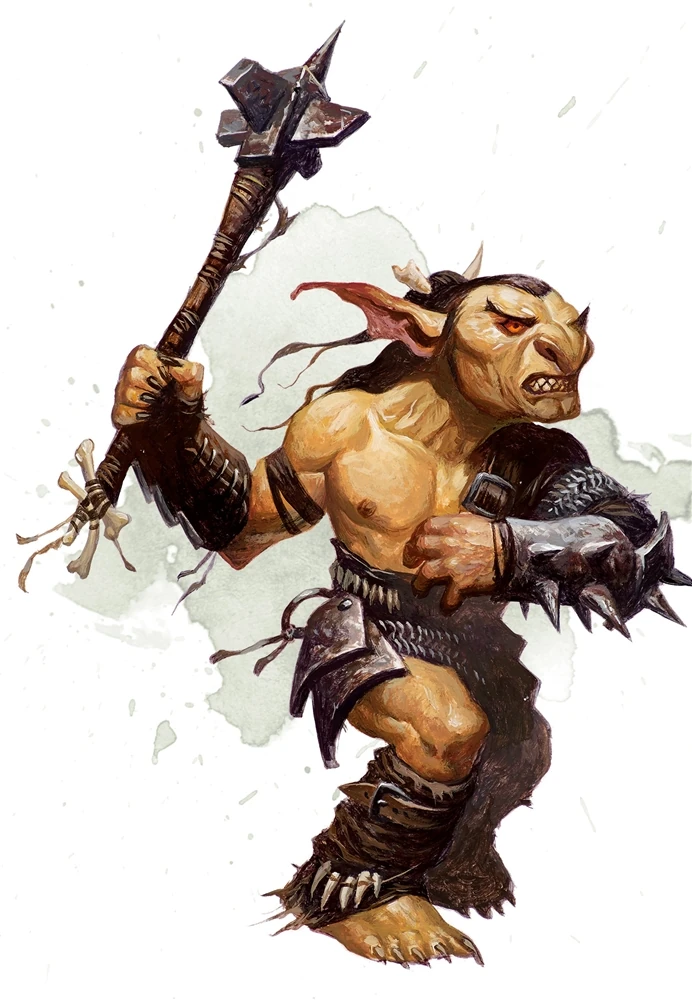Goblins
Goblins are a resilient and highly adaptable people. They are known for their cunning, resourcefulness, and innate stealth. Their reputation as industrious laborers, artisans, and quick-footed spies is well-earned. They find niches wherever they live, often forming the invisible yet essential backbone of their communities.
Goblin communities are tight-knit and built around mutual reliance and survival. They're often marginalized by dominant races, but they keep pride in their traditions and group identity. Even when terribly oppressed, they adapt and survive. Loyalty, trust, and honor are chief virtues in Goblin culture. They also respect fighting skill, cunning, and tenacity, and they prefer to work under cover of darkness— whether in lightless caves or at nighttime.
Goblin craftsmanship, esp. in metalwork, is both practical and ingenious. This reflects a heritage of innovation born from necessity. Their work is often seen as unrefined or improvised by outsiders, but Goblin smiths and tinkerers prize functionality above all.
Whether serving as spies, artificers, mercenaries, or negotiators, Goblins can be relied upon to prove their mettle. Their history of living on the fringes of society has honed their instincts. This makes Goblins invaluable allies anytime discretion, subtlety, or insight are important.
Three main ethnicities of Goblins dwell in Khorvaire: the City Goblins of Sharn, Dhakaani Goblins, and Darguul Goblins. (See 'Goblin Ethnicities', below.)
Description
Physique. Goblins stand between 3½ and 4¼ feet tall and weigh on average 40 lb. They are small, wiry humanoids with sharp features, large ears, and keen, intelligent eyes that gleam with curiosity or mischievousness. Their skin tones range from pale yellow to deep green, often darkening with age and exposure to the elements. Most Goblins are naturally lean, and their quick, precise movements sometimes seem skittish. Though their clothing is often simple and practical, many Goblins take pride in personal adornments such as piercings, charms, or scavenged trinkets that hold sentimental or symbolic value.
Age. Goblins reach adulthood at age 15. They reach middle age around 35 and are considered old past the age of 50.
Size. A Goblin's size is Small. To determine your height and weight randomly, start by rolling a size modifier:
Size modifier = 2d4
Height = 3 ft 5 in + your size modifier in inches
Weight = 35 lb + your size modifier in pounds
Suggested Names. Duul, Haara, Hass, Holan, Kador, Kel, Khaar, Khaas, Khesh, Kuula, Smok, Raat, Ruus, Skai, Suur, Uul, Uuls.
Racial Traits
Creature Type. Your creature type is Humanoid. You are also considered a Goblinoid for effects that apply to them.
Ability Score Increase. Your Dexterity score increases by 2, and your Constitution score increases by 2.
Speed. Your base walking speed is 30 ft.
Darkvision. You can see in dim light within 60 ft of you as if it were bright light, and in darkness as if it were dim light. You can't discern color in darkness, only shades of gray.
Fury of the Small. When you damage a creature with an attack or a spell and the creature's size is larger than yours, you can cause the attack or spell to deal extra damage to the creature. The extra damage equals your level. Once you use this trait, you can't use it again until you finish a short or long rest.
Nimble Escape. You can take the Disengage or Hide action as a bonus action on each of your turns.
Languages. You can speak, read, and write Human and Goblin.
Goblin Ethnicities
These are the best-known ethnicities of Eberron Goblins. You do not need to pick one of these. If you want your Goblin to be from somewhere else where Goblins live some other kind of a way, that's fine. That said, if you prefer to pick from predefined choices, here are three.
The City Goblins of Sharn
The city Goblins of Sharn will tell you their people have lived in the area since back when Sharn was ja'Sharaat. And if you wait long enough they'll tell you again. They're an urban people— with only themselves to rely on— and they combine Goblinoid traditions with practical survival strategies. They typically perform menial labor, though some work as tradepeople or mercenaries, despite facing frequent discrimination and crime. They're descended from ancient miners who built the Goblinoid stronghold that became the foundation of the city, and many Goblins remain linked to underground clans known for their skill as guides and scouts. Ultimately, Sharn's city Goblins thrive through adaptability, communal bonds, and their streetwise resilience.
Dhakaani Goblins
Dhakaani Goblins— known as golin'dar or "quick people"— are swift, perceptive, and naturally adept at stealth and cunning. Today they live in the mountain strongholds and cave systems of the Seawall Mountains in western Darguun, but their history goes back to the lost empire. Dhakaani Goblins have historically been essential as artisans, laborers, and elite spies, and to this day they provide the practical skill and intelligence vital to their culture. They leverage darkness strategically against foes, as they're comfortable in lightless tunnels and at night. These Goblins are guided by principles of duty and honor in service to their clans.
Darguul Goblins
Goblins in Darguun live hard lives, shaped by hardship and always forced to adapt. They occupy repurposed ruins and the seized former cities of Cyre, assembling makeshift communities from remnants of past conflicts. These Goblins' social status is determined by strength and cunning, and they must navigate complex tribal alliances to survive. Although they must manage violence from Hobgoblins and Bugbears as well as external threats to Darguun, they carve out harsh existences amid the constant turmoil, through their endurance and tenacity.
License
Content on this page is licensed under the CC0 1.0 Universal License, excluding images.
